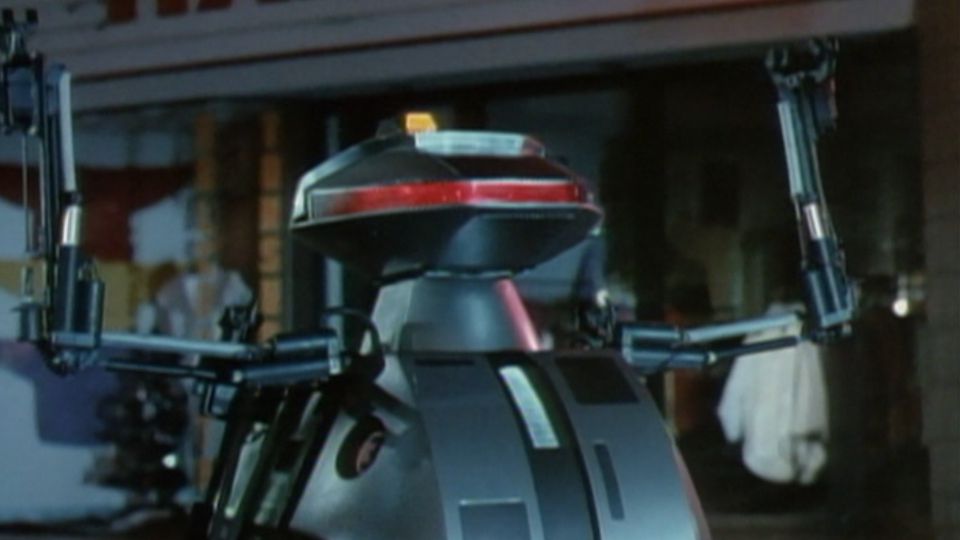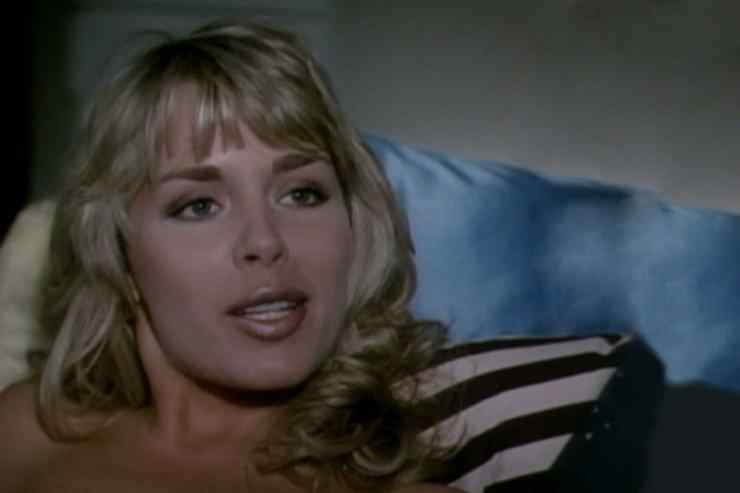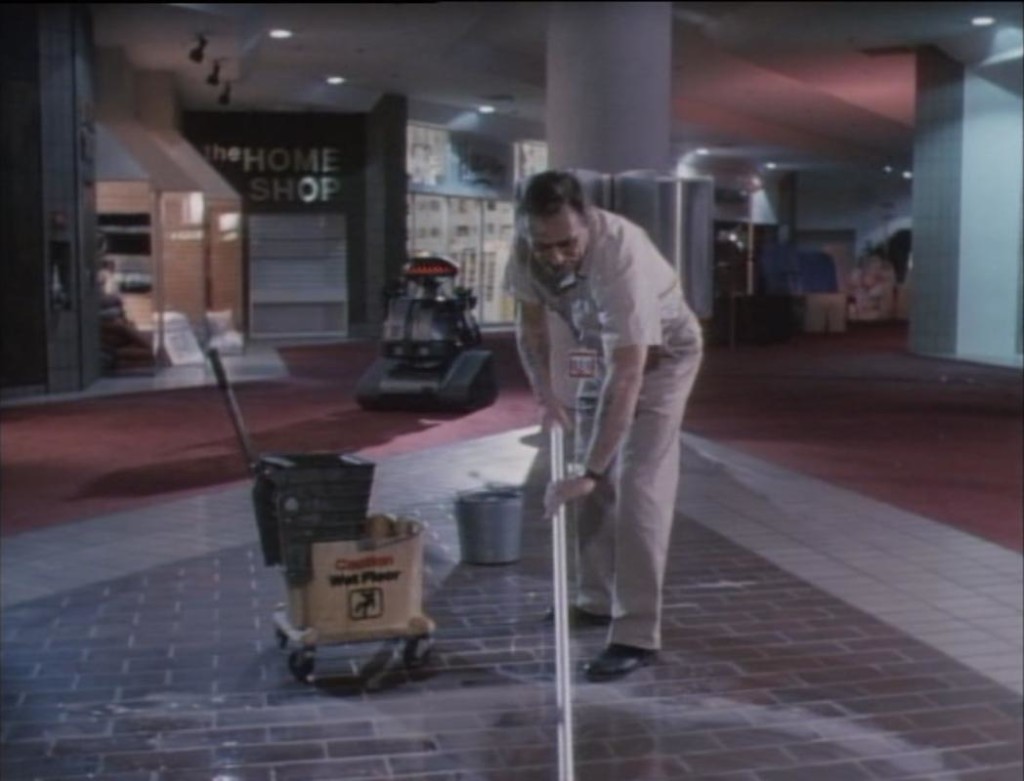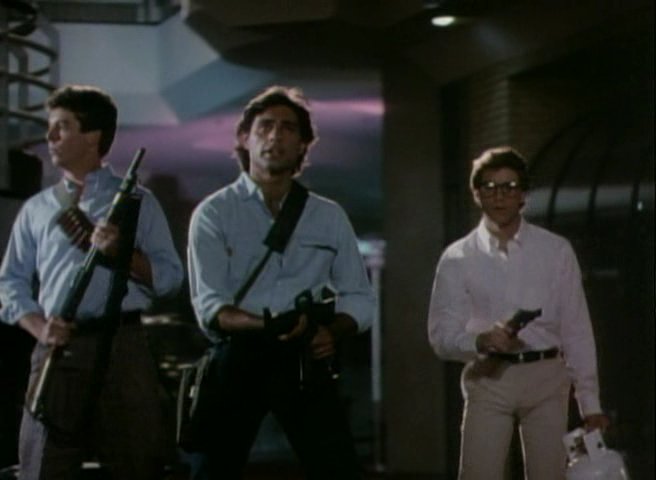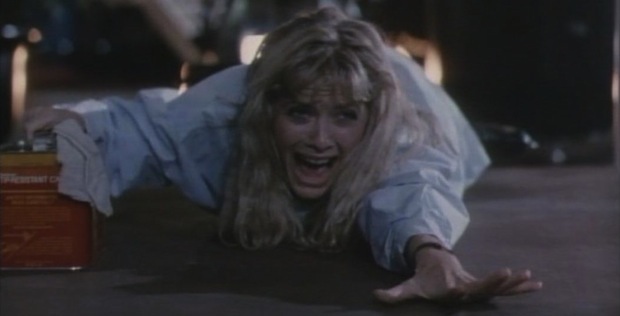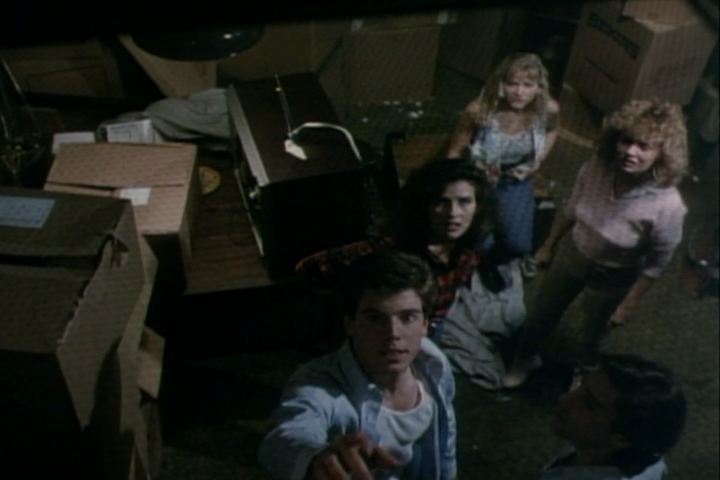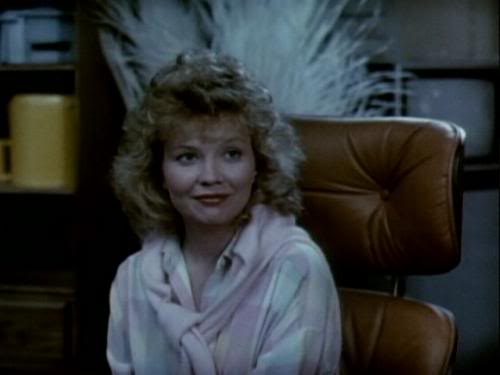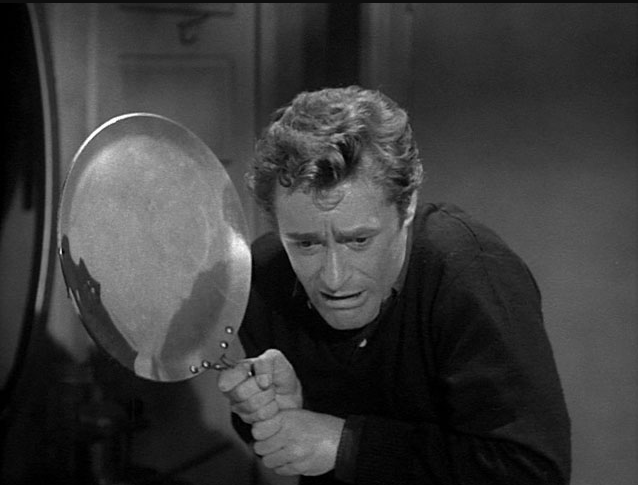
This January, in support of the Toronto Rape Crisis Centre / Multicultural Women Against Rape, friends and family have raised over $1,500 (which, when matched by my employer, totals $3,000). As a result, I now have to watch and write about thirty-one horror movies: one each night. Any donors who contributed over $30 were given the option to choose one of the horror movies I must subject myself to. After each viewing, I will write some things about said movies on this website. Be forewarned that all such write-ups will contain spoilers, and many of them will refer to unpleasant and potentially triggering situations. Today’s film was an attempt to fill a hole in my schedule with a low-budget classic I’d never seen from master of the B-Movie, Roger Corman (The Romance of the Vampires), A Bucket of Blood (1959). The entirety of A Bucket of Blood is available for free on YouTube. Follow along, if you’d like!
What happens:
Trigger warnings: suicide, male artist.
So far, this horror marathon has brought us to medieval Japan, to grimy 1970s New York, and to the contemporary British countryside – but it hasn’t yet brought us to the beatnik-filled bohemian cafés of late-1950s America. Roger Corman, the brain such B-Movies as The Little Shop of Horrors and dozens more, is here to the rescue with A Bucket of Blood, a far-out morality tale of art and murder – one, perhaps, more relevant than ever.
A Bucket of Blood opens with some freeform spoken word accompanied by a saxophone. Beat poet, Maxwell Brock (Julian Burton), venerates the role of the artist during an open mic at The Yellow Door, a local coffee shop where the bohemian artists and poets hang out. “Life is an obscure hobo bumming a ride on the omnibus of art,” he says, positing that all pursuits are secondary. Dick Miller, who is best known to children of the 1980s for his work in the Gremlins films, plays Walter Paisley, the twitchy-looking bus boy. Walter feels unsophisticated compared to the clientele he mops up after. From the way he longingly watches patrons sketch or memorizes Maxwell Brock’s poems, you sense he wishes he were an artist. Leonard de Santis (Antony Carbone), the owner of The Yellow Door often has to prod Walter back to work when he starts to daydream.
The Yellow Door conceals a secret. Amongst the many artists, stoners, and beatniks are two undercover vice cops: Art Lacroix (Ed Nelson), dressed somewhat like Clint Eastwood’s character in A Fistful of Dollars, and Lou Raby (Bert Convy), who looks exactly like a narc. Blissfully ignorant of their presence, Walter drops by Maxwell Brock’s table to be blown apart by more of his artistic truth bombs. Brock doesn’t believe in “uncreative” living. Everything must be fresh and original. Some of the other beatniks poke fun at the awkward Walter, but not Carla (Barboura Morris), the café’s hostess (and possibly Leonard’s lover). Most don’t believe he has an artistic bone in his body, but he’s determined to prove them wrong.
Walter hauls some modelling clay back to his shabby apartment, where he encounters Mrs. Swickert (Myrtle Vail), who is looking for her lost cat Frankie. They part ways and Walter begins to work the clay at his kitchen table, trying in vain to make a human face. Finding it near impossible – “Come on, be a nose!” – he tosses the clay to the floor in frustration. That’s when he hears a cat meowing from behind his wall. Somehow, Frankie has trapped himself inside the drywall. Walter takes a knife to cut the poor cat out, but accidentally stabs Swickert’s feline companion, killing it. At first devastated he’s killed the animal, Walter suddenly has a brilliant idea.
The following day, Walter proudly displays his first work of art, Dead Cat, to Carla. The sculpture is a realistic cat with a knife driven through its abdomen. (Seems derivative of Koons.) Carla and Leonard marvel at the perfect detail of the sculpture, which is the funniest part of the movie. (The “phenomenal” sculpture of Walter Paisely could probably be recreated by anyone reading this essay.) Even the beatniks inside The Yellow Door are impressed by the “crazy” artwork, and none moreso than poet Maxwell Brock, who makes an impromptu speech to praise the sculpture of Walter Paisley. In short time, Brock has become Walter’s hype-man. Soon everyone in the café, previously so unpleasant to Walter, applauds and cheers him.
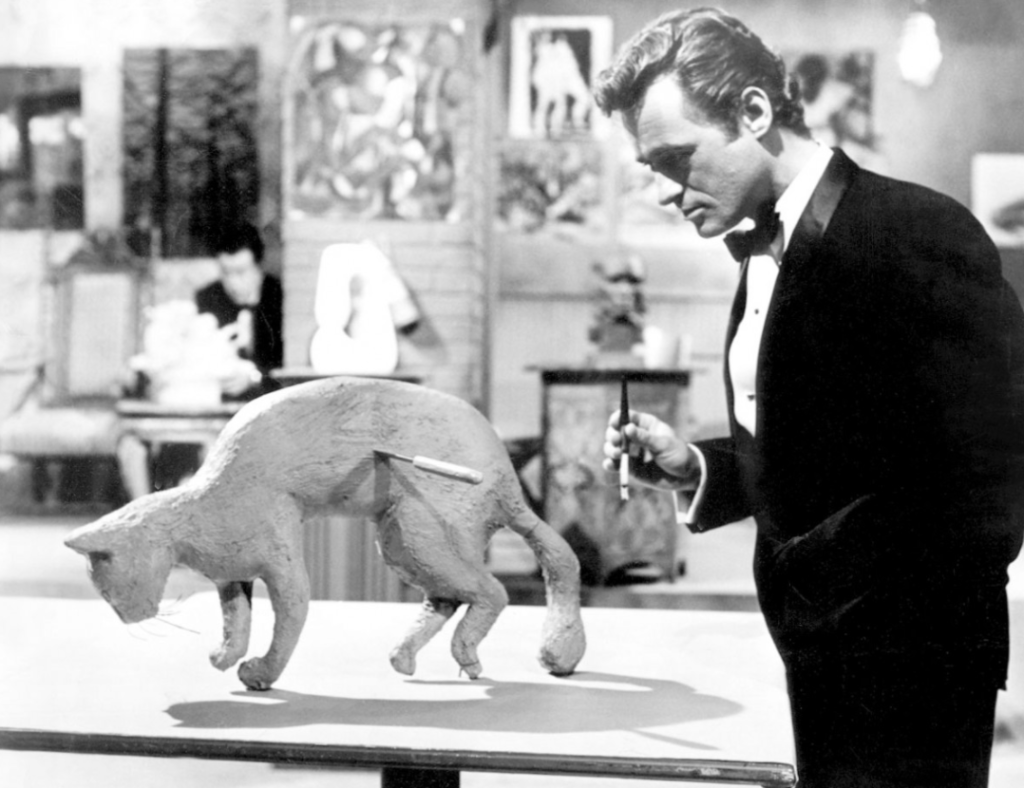
One of the adoring new fans is Naolia (Jhean Burton), who, when Walter refuses her subtle flirtations, gives Walter a vial of heroin (that’s what “horse” is, right?). Walter, a naïve man, has no idea what it’s for. Undercover cop Lou, seeing the exchange go down, follows Walter back to his apartment. Paisley’s reveries of fame and a blissful life with Carla are interrupted by a knock at the door. Lou enters, and seeing the heroin brazenly left on the dinner table, demands to know who Walter’s connection is. Walter has no idea what he’s talking about, and is further confused when Lou reveals himself as a cop, and places him under arrest. Panicking that he’ll be sent to jail, Walter clubs Lou with a frying pan, killing him on the spot.
Landlady Swickert, hearing the commotion that can sometimes accompany the termination of a man’s life, bangs on Walter’s door and demands entry. However, when she steps inside, she can’t find the source of the racket. That’s because the dead body of Lou Raby has been hidden in the ceiling. His arm slips out and begins to drip blood onto the floor, but Mrs. Swickert leaves without noticing. While blood spills into a pot that Walter has left to collect it, Walter has an idea for another masterpiece.
Art Lacroix, the other undercover cop, calls his superior and lets him know Lou has gone missing. Meanwhile, Leonard de Santis, alone at The Yellow Door, accidentally knocks over Walter’s Dead Cat statue and – spotting some real cat fur peeping out – realizes that Walter simply covered a dead cat in clay. “That little fraud …”
A folk singer plays a happy ditty about a murderer, and the fuzz descend on The Yellow Door. Walter is so anxious, he drops his tray. But it’s a false alarm; they don’t know anything. Leonard, feeling ill that Walter possibly murdered a cat for the sake of art, telephones the police. He’s interrupted by a wealthy art collector interested in buying Dead Cat. He’s even willing to pay up to $500 for the piece. All those bills smooth over any qualms Leonard had over abetting cruelty to animals.
The following morning, Walter invites Leonard and Carla over to view his new work: a full human figure called Murdered Man. Of course, it’s a clay sculpture of an agonized man with a split skull (who once was Lou Raby). Leonard nearly faints, realizing he is now complicit in murder. Carla just soaks in the masterpiece. She’s very encouraging of Walter’s work, suggesting that he build a collection and mount an exhibition. But the squeamish Leonard isn’t so sure – he figures Walter should think about doing abstract work. Move away from realism. Or at the very least, not rush to develop a body (get it?) of work. Leonard then hands Walter his cut of the cat statue sale – $50 – and Walter squeals with glee. He’s finally a professional artist!
The continued presence of police around The Yellow Door begins to be a real drag for the two-person Greek chorus of jive-talking stoners, Will (John Brinkley) and Oscar (John Herman Shaner). They’re just about to split when Walter arrives, costumed as an honest-to-goodness sculptor, complete with beret, smoking jacket, ascot, and “zen stick.” But he’s not the only one making a splashy arrival at The Yellow Door. Art model Alice (Judy Bamber) is back from Big Sur, where she went searching for Henry Miller. She is more than a little surprised to see the bus boy being asked his thoughts on art by friends and colleagues.
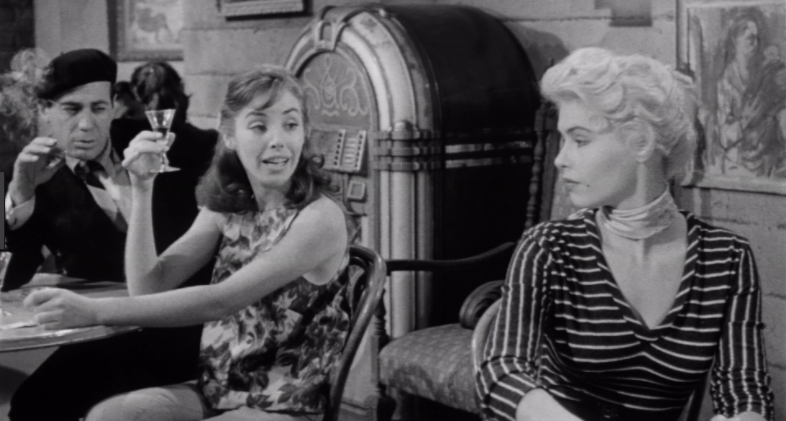
Carla suggests that Walter consider doing a female figure for his next piece – she could even model for him. (Walter, madly in love with Carla, is repelled by the idea, given his creative process.) Alice, however, is hugely dismissive of bus boy Walter, who leaves in a huff after repeated insults. Later that night, Walter tails Alice home to “apologize” and offers to pay her to sit for his next sculpture. They retire to Walter’s apartment, where Alice strips for the sitting. “That doesn’t look like very much clay,” she notes. “Oh, it’s enough,” Walter answers, and hands her a scarf for the pose. But he then uses the neckerchief to strangle Alice to death.
Walter arrives at the bohemian squat where Brock and a number of The Yellow Café’s regulars are busy enjoying an organic breakfast (or smoking reefer). He enlists the aid of some of the beatniks to bring his new sculpture inside. Viewing the figure of a seated woman mid-choke, Maxwell Brock wells with pride: “I’m honoured to know this man.” He decides he’ll throw an impromptu part in Walter’s honour that very night at The Yellow Door.
The centrepiece of the Walter Paisley celebration is a new poem by Brock that revels in the existence of the genius sculptor. Walter, the man, gets progressively hammered on booze and flattery. Having been ignored by the people he admires for so long, Walter experiences an overflow of validation. Staggering home, though, he realizes all this esteem will be short-lived unless he continues to make new and better sculptures. So Walter drunkenly attacks a carpenter working in a furniture warehouse (not this one) and takes off his head with a bandsaw. (Off-screen, of course.)

As you can imagine, Leonard nearly vomits when Walter reveals his latest sculpture is a bust (!). Leonard realizes he has to make Walter stop. He tells Walter they’ll fast-track a show of his work, as long as he doesn’t make any new statues. Carla drafts handwritten invitations and Maxwell Brock even puts on a tux (though he maintains the signature Birkenstocks). The night of the big shindig, Carla, in a lovely evening gown, accompanies Walter on his walk to the gallery space (which is really just the repurposed Yellow Door café).
During the night stroll, Walter works up the courage to share his true feelings with Carla. Try not to cringe as he asks her out, as he tells her he doesn’t want to make statues anymore – that he wants to just be her husband. Carla fears she somehow gave Walter the wrong idea (she didn’t), and while she likes him, she doesn’t like like him. As you might imagine of a man who’s killed three people already, Walter doesn’t take it well. He becomes visibly agitated, but settles down quickly enough. If Carla won’t go on a date with him, perhaps she’ll do him a favour and sit for a statue. She agrees. (No, Carla, no!)
The gallery exhibition is a swanky, formal affair, with art critics and collectors in attendance. They all seem suitably impressed with the grand total of four works on display: “He knows his anatomy.” Our beatnik Statler and Waldorf crash the party, too, just to make things interesting. But when Carla takes a closer look at the statue of the seated woman, she sees a fingernail poking through the clay. There’s a body hidden inside! When Carla screams and reveals the dead humans inside the sculptures, Walter doesn’t even deny it. The assembled art lovers erupt into a panic. “I made them immortal,” he boasts. “I can do the same for you.”
However, Art, the undercover vice cop, is (ironically) not interested in art. Only in bringing the murderous Walter Paisley to justice. Carla flees the gallery and Walter races after her. Art and a mob of exhibition attendees follow in pursuit. Walter corners Carla in the furniture factory, but loses his concentration when the voices of his victims start to speak. He’s haunted by the voices of Alice and Lou. Though he’s lost Carla, he’s still evaded the police and the others, so he returns to the scene of so many crimes: his apartment.
The voices don’t abate, and Walter clutches his skull in agony. The beatnik mob make their way to his apartment building, where Mrs. Swickert is all too happy to lead the way to Walter’s apartment. But they arrive moments too late. Walter Paisley has hanged himself from the ceiling fan, his entire body covered in clay. As poet Maxwell Brock suggests, “I supposed he would have called it Hanging Man … his greatest work.
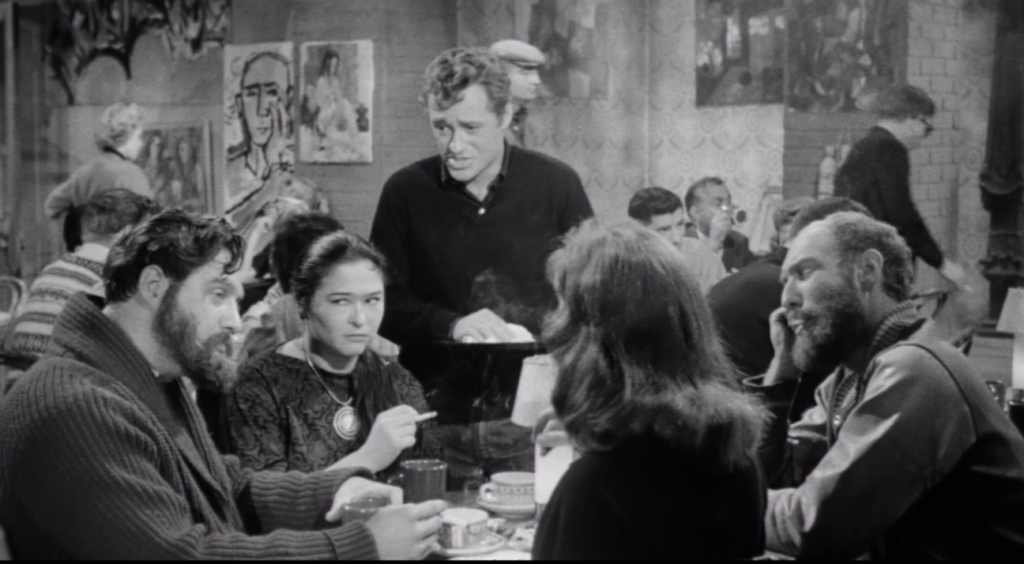
Takeaway points:
- The plot of A Bucket of Blood serves as a nice inversion of the Pygmalion myth: instead of a sculptor who falls in love with his creation, Walter is a sculptor who must murder his creations (for them to even exist). While art has frequently been seen as an expression of love – whether it be love of God, another person, or the medium itself – Corman and company pervert the process, with an art generated from bitterness and animosity. Instead of being a generative process, the art literally destroys.
- While the story and themes are largely played for laughs in A Bucket of Blood, the central conceit struck me as particularly relevant. Over the past several years (especially since news broke of Harvey Weinstein’s alleged sexual assaults), artistic industries have been publicly revealed as infected with a plague male sexual predators. (Just within the past few days, Canadian literature has witnessed reports of alleged sexual assault and misconduct by two Concordia creative writing instructors, David McGimpsey and Jon Paul Fiorentino.) Often, these men were able to get away with this behaviour for so long because they were seen as “artists.” Their work, their artistic contributions were seen as irreplaceable. And what is more important than art? The film’s poet Maxwell Brock sure doesn’t think anything is. Sure, that radio host or theatre director has harassed several women, groped several more – but what beautiful art they create! Those of us who are complicit in this behaviour are all Leonard de Santis. We know the artist is doing horrible things, but the artist is good for business, good for the industry. Though Walter is a murderer rather than a sexual predator, the film still sharply satirizes the heinous behaviour we forgive for the sake of art.
- As much as this mostly jokey B-Movie says about men and artistic pursuits, it also says a fair deal about loneliness. One could argue that what Walter seeks is not artistic fame or recognition, but merely respect. At his own party, he assures his new friend, “I wouldn’t ignore you, Maxwell. I know what it’s like to be ignored.” This portrait of deep sadness and social want is heightened by a killer performance by Dick Miller (in of his few starring roles). Walter even confesses to Carla near the end: he doesn’t want a career in art; he wants to marry her. If the sophisticates of The Yellow Door had treated the awkward bus boy well to begin with, would he ever have become a murderous, fame-hungry monster? I guess we’ll never know.
- Another thing I appreciate about A Bucket of Blood of is how it blends together two sub-genres of B-Movie – horror movie and beatnik film – and it works. Of course, this is not always the case. (A misguided viewing of Werewolves on Wheels, which attempts to meld the biker film with the werewolf film, proved less worthwhile.)
Truly terrifying or truly terrible?: I went into A Bucket of Blood assuming – perhaps unfairly – it would be terrible, but I was pleasantly surprised. It’s fun, it doesn’t overstay its welcome (at slightly over an hour), and there are some pretty good performances. When you consider the film was made in, literally, five days, it’s phenomenal. But it is certainly not scary.
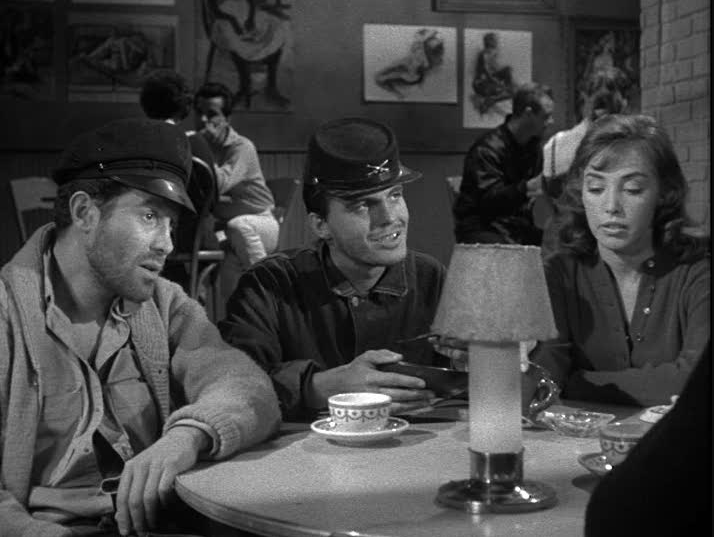
Best outfit: Not enough men wear Union Army civil war caps anymore.
Best line: “We’ll teach him he can’t murder us and get away with it.” – the voice of the dead Lou
Best kill: None of the murders in A Bucket of Blood are fully witnessed, but my imagination ran particularly wild when Walter clobbers the undercover cop with a frying pan. He brings it crashing down on the officer’s head vertically. Combine that with the blood on the edge of the pan and the split face of the resulting sculpture – that’s one powerful chop!
Unexpected cameo: The folk singer who entertains diners and coffee drinkers at The Yellow Door is none other than Alex Hassilev, who would later become known as one-third of folk idols, The Limeliters.
Unexpected lesson learned: If you hear a cat trapped within the walls of your apartment, don’t try stab the kitty a route out.
Most suitable band name derived from the movie: Murdered Man or Dead Cat. Or perhaps: Zen Stick.
Next up: What We Do in the Shadows (2014).
